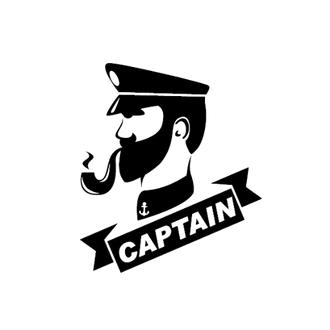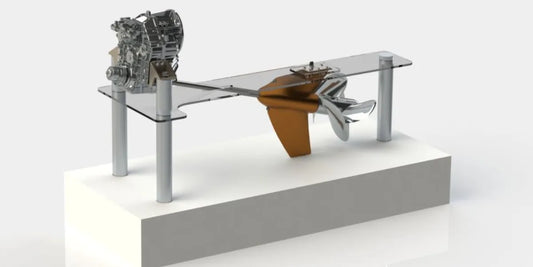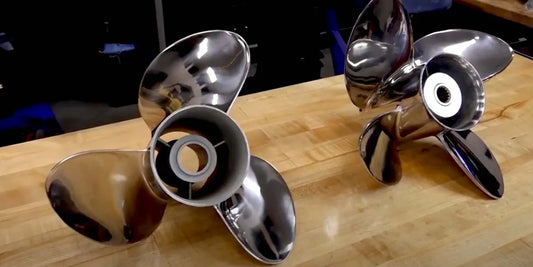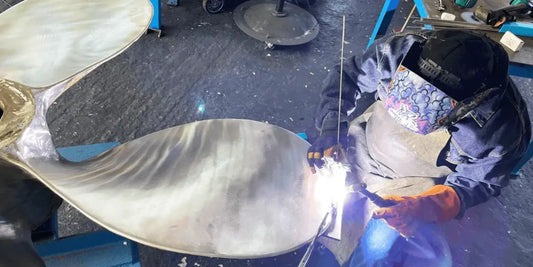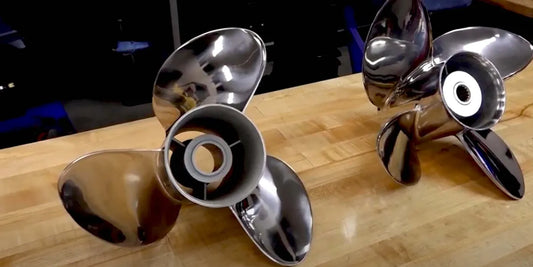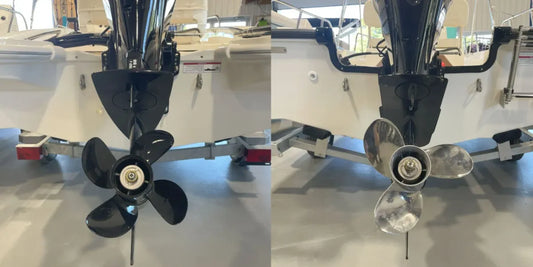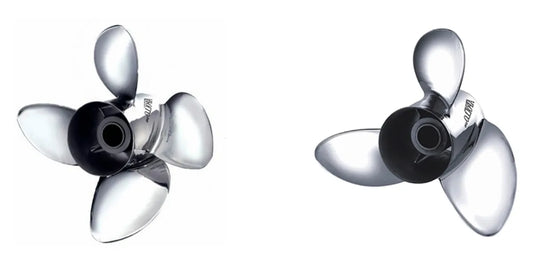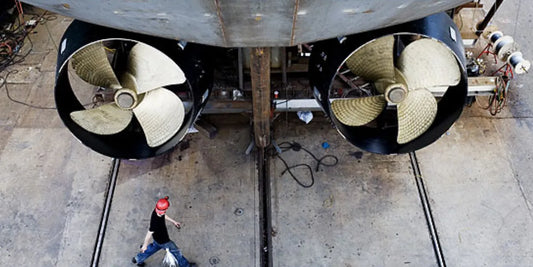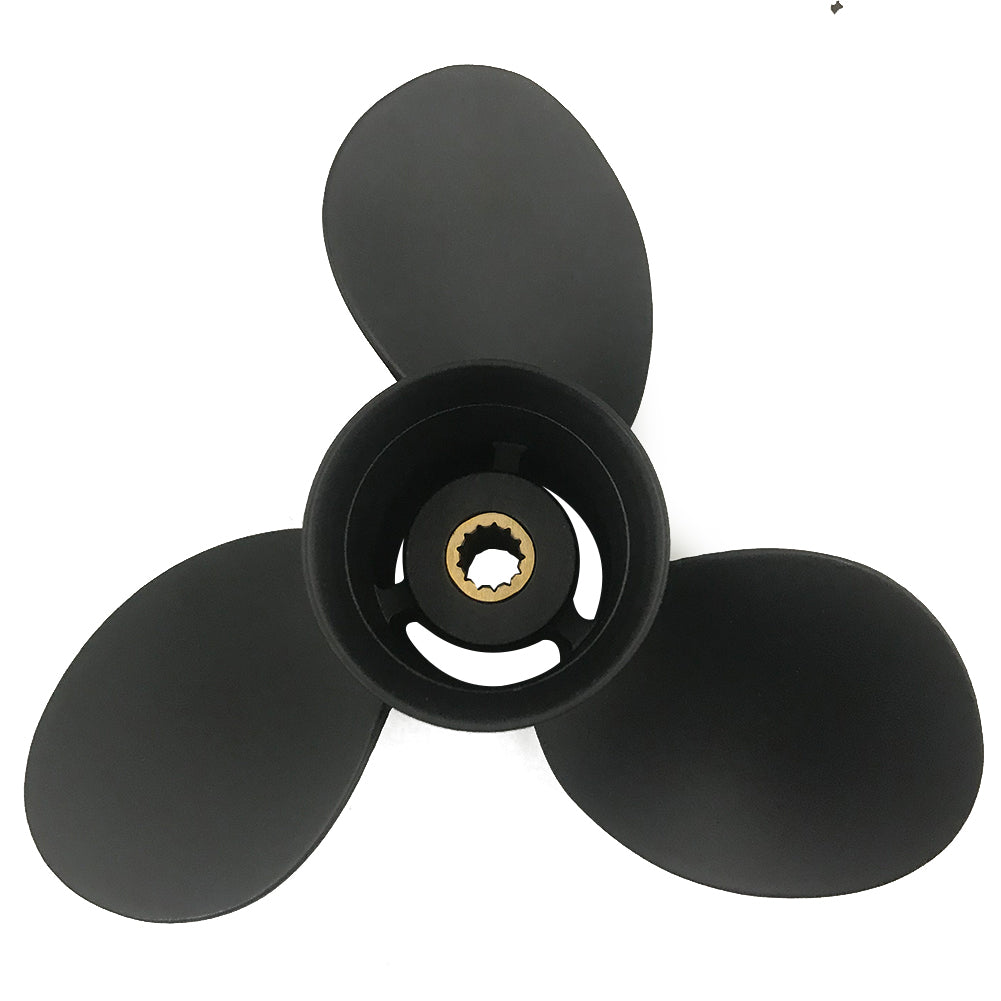Choosing the right propeller for your vessel is more than just a technical choice. It directly affects performance, efficiency, and functionality out on the water. Among the most significant considerations is whether to go for a 3- or 4-blade prop. Although they may seem similar at first glance, each has distinct benefits and drawbacks, depending on your vessel type, its purpose, and boating goals. This article explores the primary differences between 3-blade and 4-blade propellers, examining their impact on speed, fuel economy, handling, and overall enjoyment. Understanding these vital distinctions will enable you to make an informed choice that corresponds to your requirements, thereby maximizing the working potential of your vessel.
Understanding Propeller Design

Propellers Introductions Countedblades
Propeller blade count is a significant factor in determining thrust, drag, and efficiency. 3-blade propellers, mostly in recreational and commercial vessels, are built for balanced speed and fuel efficiency, and so are fair general applications. Due to lower drag compared to higher blade counts, the 3-blade also achieves higher top speeds. On the other hand, a larger surface area allows the 4-blade to provide acceleration, better bob handling, and a more substantial footprint in choppy conditions or under heavy load. This extra performance results in slightly diminished top speed and efficiency due to the increased drag. Hence, a good understanding of these trade-offs is necessary before choosing the blade count, as the blade count affects fuel consumption, handling, and propulsion efficiency, depending on different operating conditions and the vessel's set requirements.
Power of blades in performance
In a broad sense, a blade is a geometric shape whose shape needs to be taken up so that a propeller can function. Each shape exhibits various effects on water flows, including thrust and resistance. For a larger surface area, blades are expected to produce more thrust for heavier-duty work or for vessels working under greater drag. However, this may increase drag, which can help diminish fuel efficiency and reduce scarce top-end speed.
Conversely, narrow or tapered blade designs are constructed with the intention of compromising drag and favoring high-speed performance while maintaining smooth hydrodynamic flow. These are the preferred configurations for racing or fast-moving speedboats. Furthermore, blade curvature, rake angle, and skew are also factors to consider when evaluating water displacement and resistance to cavitation. Very high rake angles enable the capacity to perform under force loads, so very high rake knives are used in high-load conditions. Skew blades reduce vibrations and noise, giving the operation a smooth feel.
Recently, computational fluid dynamics (CFD) analysis and material engineering have been refined to enable designers to customize blade shapes with great precision. For instance, a few alterations in blade pitch or camber may be beneficial to the ship's propulsion efficiency, thereby reducing cavitation and enhancing the vessel's stability. These developments continue to refine the propeller for the specific requirements of contemporary maritime applications.
Benefits Profited from Different Blade Configurations
Depending on the maritime application, different blade configurations in propeller design offer various benefits to choose from. Thereby, fixed-pitch propellers (FPPs) are appreciated for their simplicity and ruggedness, giving the best performance for steady load applications. These configurations require the least amount of maintenance and are mostly favored for cargo vessels and tankers, where operations are generally predictable.
In contrast, the controllable-pitch propeller enables the dynamic setting of the blade pitch, giving it the advantage of good efficiency in varying operating conditions. When subjected to variable speed and load, CPP systems yield good fuel economies and decrease wear on engines, making them an excellent choice for ferries and offshore support vessels. Moreover, sophisticated CFD analyses have shown that a CPP design offers a maximum of a 15% advantage in fuel efficiency across varying operating conditions compared to fixed-pitch designs.
An equally innovative design is the ducted or shrouded propeller, commonly found in high-thrust, low-speed applications such as tugboats or harbor vessels. The nozzle enhances thrust, reduces cavitation, and, in essence, improves propulsive efficiency by optimizing the water flow around the blades. In contrast, under certain conditions, these propellers can generate almost 20% more thrust than an open propeller of approximately equal dimensions.
Lastly, twin or contra-rotating propeller types offer superior propulsion by balancing the torque losses, thus regaining efficiency from the wake flow. These types operate with significantly reduced vibrations and noise, ensuring smooth operation —a crucial characteristic for passenger vessels and research ships. Modern studies on contra-rotating arrangements report that the propulsion efficiency can improve by 6 to 10%, thereby making them a popular choice in the latest marine engineering.
Given the right blade arrangement, designers can practically employ it to enhance vessel performance, fuel economy, and operational life, a clear reflection of how customized engineering solutions address the varied requirements of the maritime industry.
3-Blade vs 4-Blade Propeller: Key Differences

Performance Features of 3 Blade Propellers
Considered efficient and balanced between performance and operational costs, 3-blade propellers have their design optimized for drag reduction, thereby increasing the potential speed and fuel economy for vessels that operate in various water bodies. Additionally, 3-blade propellers, which have a smaller blade surface area to resist force compared to 4-blade propellers, are a suitable option for use at high RPM.
While this design utilizes greater efficiency, thrust may be slightly compromised at lower speeds. Fewer blades also create a higher vibration level, which may, under certain load conditions, affect vessel stability. Studies suggest that three-blade systems are especially suited for light craft, such as speedboats or racing vessels, where agility and speed are primary considerations. Modern 3-blade propellers continue to innovate in the realm of propulsion, utilizing optimal blade geometry with modern materials and coatings that enable precise deployment for a wide range of maritime applications.
Advantages of 4 Blade Propellers
Four-blade jet propulsion systems offer a set of performance enhancements that are particularly well-suited for certain marine applications. One is the provision of thrust and efficiency at low speeds, ideal for vessels that require high maneuverability, such as tugboats, trawlers, or cruising yachts. The fourth blade reduces the load on the others, promoting smooth operation and less vibration; hence, it is quieter and more comfortable to ride on.
Continue with the advantages in the realm of cavitation, in particular, where the 4-blade impeller is the solution for higher stress operating conditions. This balances consistent performance requirements as seawater becomes churned up and turbulent. The other aspect, however, is the larger blade area, which gives the vessel a better grip in choppy seas, making vessel control more adequate, particularly during sharp maneuvers or the final stages of docking.
Bearing in mind that modern fabrication techniques have given lightness and greater strength to 4-blade systems, in addition to increasing innovations in manufacturing that significantly enhance features such as the strength-to-weight ratio, with only minimal power losses since drag forces oppose efficient propulsion. It has also been reported that four-blade propellers are typically preferred for vessels with two engines, as they provide balanced propulsion, even power distribution, and good performance. In summary, additional thrust, reduced vibration, and increased stability contribute to the greater relevance that 4-blade propellers have in both heavy-duty and leisure marine environments.
Comparative Analysis: 3 Blade vs 4 Blade
A comparison of 3-blade versus 4-blade propellers must focus on performance efficiency, maximum speed potential, fuel consumption, and operational stability.
Some conventional designs for 3-blade propellers accommodate higher speeds for greater efficiency, due to reduced drag and a smaller surface area in contact with the water. These propellers can achieve higher top-end speeds for vessels, making them suitable for applications where rapid acceleration and top-end speed are paramount. Otherwise, they suffer a loss of low-speed thrust and somewhat lower stability in turbulent or heavy-water conditions. This can cause cavitation to increase in certain instances, especially for vessels working under heavy loads or unpredictable conditions.
Conversely, 4-blade propellers operate with more thrust and stability due to their larger blade area. This makes them ideal for boats operating under heavy loads, in rough waters, or those requiring precise handling and control. Extra blades then increase balance and reduce vibrations, while also improving fuel efficiency during cruising. A 4-blade prop will also, by design, give a better plane time and will better distribute power in a twin-engine scenario.
In numerical terms, studies indicate that low-speed thrust can be increased by up to 15% with 4-blade propellers compared to 3-blade versions. Their drag, however, usually means they bring down top speed, just marginally, by between 1% and 3%. It is this trade-off that highlights the importance of selecting a propeller in accordance with the intended use of a tanker and its operating profile.
It depends on specific design features and intended use: choose between three or four blades. Three blades are ideal for high-speed thrust and lighter loads. In contrast, four blades provide higher thrust, greater stability, and increased efficiency under heavy-duty situations, creating a balanced medium for multipurpose maritime use.
Impact on Boat Handling and Efficiency

How the Number of Blades Influences Maneuvering
The blade count of the propeller plays a decisive role in determining how the vessel responds and handles under varying conditions. A 3-blade propeller with a smaller surface area presents less drag, generally improving maneuverability at higher speeds. This means the boat will be able to accelerate faster and turn more sharply, offering an exciting performance for boats that prioritize speed, such as racing boats and light craft. However, such a configuration might hinder some low-speed, precise maneuvering due to the slight grip it offers in the water.
The opposite occurs with 4-blade propellers, however: with an enhanced surface area comes increased water resistance, which translates into high thrust and control, especially at low speeds and under heavy loads. Steering with utmost precision is absolutely crucial in troubled waters, such as when great forces are exerted in towing. CFD studies also highlighted that the extra blade contributed to reducing cavitation and vibration, resulting in smoother operation from a practical perspective, while not adversely affecting directional stability. The drawback in this regard is in top-end speed, where the drag of the extra blade surpasses that of the 3-blade propellers, preventing maximum velocity from being achieved.
Winds of change: The choice of the number of blades depends on the vessel's primary working environment. For high speed and smooth turning at pace, 3-blades are considered the very best. For better control in adverse working conditions, a 4-blade propeller offers the best maneuvering efficiency, a compromise that is suitable for the marine environment.
Fuel Efficiency: 3 Blade Versus 4 Blade Prop
The blade count, design, and operating conditions define the fuel efficiency of a propeller. At high speeds, 3-blade propellers are considered to offer better performance since they induce less hydrodynamic drag due to the smaller hydro-surface area being in contact with water. Less resistance means the engine spends less energy maintaining a higher speed. This is why vessels equipped with a 3-blade propeller typically yield the highest fuel efficiency in both speed and cruising operations.
Theoretically, four-blade propellers offer better thrust at lower speeds and during acceleration. In fact, an additional blade will generate more propulsion as it provides more grip in the water, especially under heavy loading conditions or rough seas. This type of propeller obviously increases the surface area and, in turn, drag. However, optimally spreading out the load can actually improve fuel efficiency, particularly when a vessel is operating in situations that demand higher torque, such as while towing or maneuvering.
The studies thus indicate that the selection between a 3-or 4-blade option must take into consideration engine power, hull type, and application. Long-distance cruising at fixed speed optimized for fuel consumption would favor a 3-blade propeller. However, 4-blade propellers could yield better fuel utilization if variable speed requirements and precise maneuvering are needed, such as for fishing boats or workboats.
Speed and Acceleration Considerations
As a ship moves, it accelerates or decelerates primarily because of the propellers it employs, each having unique performance trade-offs. A 3-blade propeller, being synergistically less in surface area than others, would produce some drag, albeit not much; this would allow for higher top speed and better gas mileage at cruising speed. Therefore, such a configuration is preferred when maximum velocity is paramount.
In contrast, 4-blade props are considered better for acceleration and thrust generation, especially at low speeds. The fourth blade enhances the consistency of water flow and smoothness, resulting in less cavitation and generating higher lift. Therefore, a 4-blade propeller would be more suitable for vessels operating under heavy loads or in hostile environmental conditions such as rough seas. On the performance data front, boats with a 4-blade propeller generally show less time to plane and improved downstream handling in complex maneuvers. However, they may sacrifice some efficiency at top speed.
Overall, speed and acceleration should be considered based on the mission requirements to ensure that the performance parameters of the propeller being used align with the vessel's operational profile.
Selecting the Right Propeller for Your Vessel

Factors to Consider When Choosing Blade Count:
Power and Torque of the Engine: The appropriate blade count of a propeller must always be compatible with the engine's power and torque. Higher blade counts, typically five or six blades, are preferred in high-torque engines to maintain a greater grip with water while reducing cavitation. In contrast, lower-powered engines perform better with three-blade propellers, as they are relatively lighter and create less drag, thereby enabling them to achieve a higher top speed.
Vessel Application and Load Conditions: Operational requirements continue to be considered for the specific blade number. Towage operations, for example, with vessels handling heavy loads from time to time, require a four-bladed propeller as it provides better thrust and has good low-speed performance. Racing or high-speed efficiency are the priorities for vessels that, in contrast, place a high value on a three-blade design, allowing for maximum velocity and minimum hydrodynamic resistance to be attained.
Hydrodynamics: The effect of blade count on water resistance and efficiency has been extensively documented in several studies. Fewer blades mean less drag and greater potential for achieving top speed; however, more blades allow for a more even distribution of power and, thus, better handling during quick changes of course and in rough water conditions. The tradeoff between drag and stability is to be carefully computed, examining the operational profile of the vessel.
Cavitation Risks: Low blade counts, especially under high loads or speeds, increase the risk of cavitation by increasing the pressure differential across each blade of the water. In contrast, more blades share the load over a larger surface, thus ensuring a lower probability of cavitation but compromising speed and efficiency. These are therefore preferred and, in fact, almost necessary for vessels operating in violent or turbulent water situations.
This is a delicate balancing act that always involves an in-depth understanding of the vessel's performance requirements, the engine specifications, and the prevailing environmental conditions. Moreover, in recent years, advances in propeller manufacture, combined with custom blade design and materials, have led to more options for a customized approach to addressing specific performance limitations.
Matching Propeller Type to Boat Usage
It is necessary to select a propeller according to the boat's intended use in order to sustain its performance, fuel efficiency, and operational reliability. From high-speed recreational crafts to heavy-duty commercial vessels, different types of boats require propellers that are specifically designed to meet their respective demands.
In fast boats, such as speedboats or performance watercraft, fewer blades—the most typical number is three—are used to reduce drag and increase velocity. Such propellers are capable of attaining very high RPMs, which enable rapid acceleration and efficient top speed attainment.
In opposition to this are workboats, tugboats, or cargo ships that mostly employ four or more blades. The higher number of blades aids in smoother operation during higher loads and helps counteract pushing forces, considering the weight involved in operations. Propeller materials, such as stainless steel and aluminum, are also selected according to the operating conditions of the vessel, with stainless steel providing the strength required to resist deformation in high-torque applications.
For shallow water boats, specific propeller characteristics, such as cupped blades or a smaller diameter design, are installed to generate thrust and minimize damage due to contact with floating debris or the sea bottom. In addition, there are variable-pitch propellers, allowing operators to set the blades to a desirable angle that suits their requirements under changing conditions.
According to industry research, a well-maintained vessel wastes up to 10-15% of fuel, in addition to engine wear and operational cost reductions over time. Proper selection of the propeller, after thoroughly evaluating the vessel's application and environmental conditions, will ensure smooth, safe, and efficient operation of the boat.
Expert Recommendations for 3 and 4 Blade Props
Some of the fundamental distinctions between 3- and 4-blade propellers lie in their performance characteristics and specific applications. 3-blade propellers are usually preferred because they allow for a higher top speed by producing less drag. This configuration is suited whenever the need arises for a compromise between speed and fuel economy, as in pleasure boats or light-commercial vessels used at mid- to higher-range speeds. A 3-blade prop may also perform better in scenarios where thrust and acceleration are not paramount.
In contrast, 4-blade propellers are optimized for low-speed handling, better hole shot, and fairer performance in rough water conditions. Adhesively, a greater area of the blade surface grips in the water, providing superior handling and reduced vibration. Hence, for towing activities such as water skiing or wakeboarding, 4-blade propellers will be excellent. Additionally, the same types of propellers will benefit vessels with heavy loads that must operate in rough water. Studies indicate that 4-blade propellers tend to provide slightly lower top speeds but better fuel economy at cruising speeds, as the engine load remains more constant.
The propeller pitch and diameter must be kept in harmony with the engine's recommended range of operation; if not, the engine may suffer from under- or over-revving, resulting in lower performance and perhaps engine damage. The evolution of propeller materials and the shaping of blades into more customizable designs enable operators to select a propeller suited to their vessel's design and optimized for overall efficiency in various operational states.
Conclusion: Making Informed Decisions

Summary of Propeller Benefits by Number of Blades
A difference in propeller design must be taken into account when selecting the correct configuration for a vessel's specific needs. A 3-blade propeller will generally have more top-end speed compared to a 4-blade. They are also more fuel-efficient since greater water resistance is created by increasing the surface area. Hence, in terms of focusing on speed and economy, 3-blade propellers would be appropriate for small boats or other types of craft intended for high-speed cruising.
Conversely, a 4-blade propeller can provide maximum thrust and stability, especially at lower speeds. This additional blade enhances acceleration and facilitates handling in rough water conditions, making it highly suitable for large vessels, towing, or operations that require precise control and maneuverability. Additionally, a 4-blade configuration enables better performance maintenance over a broader range of RPMs, which is particularly useful when consistent levels of performance are required under variable loads, such as during sustained operation.
Ultimately, the operator must factor in factors such as the type of usage, load, and desired performance characteristics. When a propeller is appropriately chosen for a vessel, the engine consumes less energy, the mechanical strain on the parts is lessened, and the propeller and engine will last longer.
Concluding Thoughts on Choosing the Proper Propeller
A correct propeller optimizes the performance of a vessel, in my opinion. Consider engine specifications, vessel size, and average operating conditions to ensure the propeller meets your needs. Then, there is the balance between speed and fuel efficiency to consider, as an overly biased design toward one tends to compromise the other. Smooth operation, better handling, and reduced fuel consumption all contribute to warm memories of pleasant cruising with the right propeller.
From my perspective, the choice of a propeller should consider durability and impart knowledge about how pitch, diameter, and blade count influence propulsion dynamics. The time invested in evaluating this pays off in the long run because it causes less wear on both the propeller and engine, thereby saving maintenance costs and prolonging the operational life of the vessel.
I sometimes seek the advice of professionals or suggest performance testing if the boat operator remains in doubt. Each vessel has its subtle distinctions, and there might be some trial and error at the beginning. However, once the right choice is made, energy and hours of satisfaction during operation are evident and bright. In making a conscientious, well-thought-out, and grounded in a clear knowledge of one's vessel's needs, a reliable and steady performance from a propeller would have no chance to evade the boat owner.
Future Trends in Propeller Design
When considering future developments in propeller design, I believe the industry is heading towards innovations that prioritize efficiency, sustainability, and flexibility. One of the trends includes the use of advanced materials, composites, and lightweight alloys that offer greater strength-to-weight ratio and increased durability. These materials help reduce drag forces and overall fuel consumption, which emphasizes sustainability and the reduction of environmental impact. In addition, CFD and higher simulation techniques are widely used nowadays; manufacturers design remarkably optimized blades that fit very specifically into the vessel requirements, thereby reducing approximation.
There is, in my view, also another vital trend toward hybrid and innovative technologies on propellers. With the rise of hybrid propulsion systems, there is an increasing demand for propellers that will smoothly accommodate power inputs from multiple sources, whether diesel or electric. The second option for advanced propellers is to have smart propellers equipped with sensors and data collection capabilities that provide real-time feedback to operators regarding performance and wear, enabling the scheduled retention of the vessel and extension of its operational life. These innovations respond to the demands for reliability and efficiency in a competitive marketplace.
Modular design, for instance, the adaptation for different types of vessels to the evolving scheme of behind operations, can be attributed to another field of focus. Propulsion units with interchangeable parts or variable pitch angle offer greater flexibility, allowing users to adjust setups according to variables such as speed, load, or environmental conditions. Thus, these developments are propelling themselves toward models that lack maximization of functionality because the real demands of vessel operators and regulatory requirements evolve around them.
Reference Sources
-
3 Blade vs. 4 Blade Propeller - Michigan Wheel
- Explains the differences in pitch and performance between 3-blade and 4-blade propellers.
-
3-Blade vs. 4-Blade Prop: What Are The Differences? - Reel Coquina Fishing
- Discusses cost-effectiveness, maintenance, and performance for different boating needs.
-
Which Prop is Better For Your Boat: 4 Blades or 3 Blades? - BoatTest
- Compares efficiency and performance metrics of 3-blade and 4-blade props.
-
What's the Difference Between 2, 3, and 4-Bladed Propellers? - Airplane Academy
- Highlights power, drag, and noise differences, applicable to marine and aviation contexts.
-
3 Blade Propeller vs 4 Blade Propeller - Boat Design Forum
- Provides insights into efficiency and design considerations for both prop types.
Frequently Asked Questions (FAQs)
Discrepancy Between 3-Blade and 4-Blade Propeller?
The primary difference between the 3-blade and 4-blade models lies in their respective designs and operational characteristics. The 3-blade prop offers generally higher top speeds due to its lower drag; this makes it suitable for use in racing and other high-speed applications. On the other hand, a 4-blade prop gives you superior handling at low speeds and a better hole shot that will aid heavier boats, especially when ditching or rough-water conditions arise. The fourth blade adds greater lift and thrust to the 4-blade prop, thereby providing better acceleration. So, which one to choose really comes down to what the boat is designed to do.
How Does the Number of Blades Affect Boat Performance?
Whatever the purpose of the boat, there is a significant impact on performance, i.e., speed, acceleration, stability, and efficiency when the number of blades of propellers is changed. The top-end speed is believed to be slightly greater with 3-blade propellers due to their smaller blade area, which causes less drag at higher rpm. On the other hand, 4-blade propellers tend to provide better low-speed pull as well as a steadier ride in rough waters. This is ideal for recreational boats that require precise control during low-speed maneuvers. The addition of a blade to propellers typically improves the fuel efficiency of the boat and its performance at various speeds.
What Are the Benefits of a Four-Blade Prop Over a Three-Blade Prop?
There are a few advantages a 4-blade prop might have over a 3-blade one, especially at low speed and acceleration. The extra blade prevents ventilation and cavitation from occurring, which in turn makes the boat faster, of course. A 4-blade prop will also outrun a 3-blade, given more "hole shot," thereby allowing the ship to plane quicker. This makes it an adequate choice for heavier boats or those that frequently carry loads. If one holds that a 3-blade prop is more efficient at high speed, then he should know the two-blade prop is thoroughly worthy of comparison.
When Should You Choose a 3-Blade Prop Over a 4-Blade Prop?
Typically, choosing a 3-blade propeller is best when top speed and efficiency are the primary considerations. If the fastest RPMs are to be attained on a light boat, a 3-blade propeller is best for less drag and more efficient RPM attainment. A 3-blade is priced more by the racing crowd, as a boost in streamline efficiency at WOT is desired. 4-blade props are better for handling and stability in recreational boating and choppy water conditions.
Will a 4-Blade Prop Enhance Fuel Economy?
Yes, a 4-blade prop can sometimes lead to increased fuel economy at lower speeds. Being able to generate better pull at low speeds and efficiency over a broader range of rpms, a 4-blade prop creates smoother speed transitions. The motor then does not have to work as hard to maintain speed, which is beneficial for overall fuel economy. On the other hand, fuel economy benefits depend on the shape and weight of the boat's hull, as well as its actual working conditions.
What is the Impact of Blade Area on Prop Performance?
Finally, the blade area affects prop performance insofar as it influences drag, thrust, or efficiency. A prop with a greater blade area translates to higher lift and stability values, especially in turbulent water. On the other hand, an increase in drag is one price to be paid for a bigger blade area, which could pose problems with attaining higher speeds. Conversely, props with lower blade areas, typically the 3-blade types, are more conducive for high speeds, but low-speed handling and acceleration pose a problem. Therefore, the selection of blade area is crucial in deciding which prop is best suited for a particular boating need.
How Hull Design Affects Prop Selection?
Since different hulls interact with the water, prop selection can also be influenced. For instance, deep-V hulls may require a prop that is good in rough water or that makes a preference for a 4-blade prop for better stability and control; flat-bottom hulls, perhaps, should go toward a 3-blade prop that can raise top speed and efficiency. Furthermore, a boat's weight and application may lean one way or the other as to which prop design is best, hence the importance of the boater considering their hull type when choosing between a 3-blade and a 4-blade prop.
